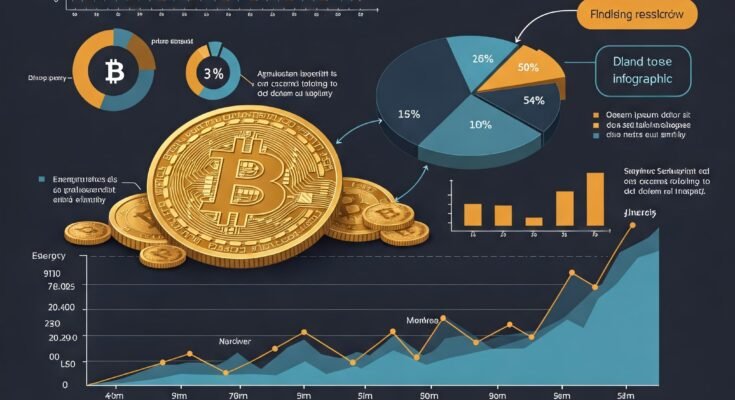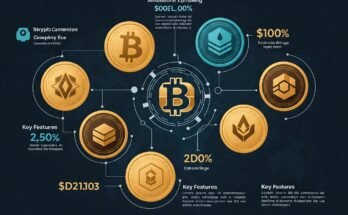Bitcoin Mining, the first cryptocurrency, is more than just a digital asset – it’s the backbone of an entire decentralized financial system. Mining, one of the most essential components of Bitcoin infrastructure, is a process that both secures the network and generates new coins. Mining, however, is not an easy or cheap endeavor. The costs of mining, specifically against the market capitalization of Bitcoin, have also come to the forefront in understanding the profitability and sustainability of such a virtual gold rush.
The Economics of Mining
Bitcoin mining is the activity of finding difficult math problems in order to validate transactions on the blockchain. This reward is halved roughly every four years in a process known as the “halving,” which heavily influences miners’ revenues.
The mining process requires high computational power, which in turn needs high electricity usage. The electricity-hungry nature of mining has been a point of concern over environmental sustainability, but it also raises an important economic question: Is Bitcoin mining economically feasible anymore with its rising cost?
Elements of Bitcoin Mining Costs
The expenses associated with mining Bitcoin may be generally categorized into three major areas:
Hardware Costs: ASICs (Application-Specific Integrated Circuits) are specific hardware required to mine Bitcoin profitably. Such computers may cost tens of thousands of dollars and have minimal periods of usage due to the rapid pace of technological advancement and wear-and-tear from constant usage.
Based on geography and power sources, electricity costs can be the difference between profitability and failure in mining. In some countries, like China (before mining crackdowns) and Kazakhstan, cheaper electricity prices made mining possible.
Operational Costs: These include costs of cooling equipment, maintenance, internet, and staff. Big mining farms often require warehouses and cooling centers to prevent machines from overheating, thus adding another cost burden.
Break-Even Cost of Mining
The break-even cost of mining a single Bitcoin widely varies depending on the above parameters. At the moment, as of 2025, it is estimated that the average cost of mining one Bitcoin ranges between $25,000 and $40,000. Miners in certain regions with cheaper electricity rates and optimal processes might fare better below $20,000. In regions with higher electricity rates, mining is not worth it unless the price of Bitcoin in the market remains high.
Market Price Dynamics
The supply and demand, investor sentiment, macroeconomic fundamentals, and regulatory environment shape the market price of Bitcoin. Historically, Bitcoin has witnessed grand price swings, from levels just above $1,000 in early 2017 to a record high above $69,000 in late 2021.
This volatility creates a dynamic setting for miners. This increases the overall hash rate—the combined processing power of the Bitcoin network—and increases mining difficulty, which becomes more costly and hard to mine new blocks.
However, when the price of Bitcoin drops, mining is less profitable and some of the miners shut down operations, decreasing hash rate and eventually decreasing difficulty.
Post-Halving Impact and Recent Trends
. This reduced miners’ main source of revenue by half, heavily impacting profitability. The market was anticipating this, and a number of miners upgraded equipment to more efficient models or moved operations to nations with lower electricity prices prior to this.
Upon halving, the price of Bitcoin appreciated due to decreased supply but also produced a consolidation of miners. Smaller or inefficient mines struggled to make it on a profit margin, thus leading to a more centralized mining scene dominated by the larger-scale players.
Profitability versus Sustainability
Though miners are interested in profitability, the overall query is regarding the sustainability of the Bitcoin mining scheme. Others pose that mining’s environmental impact—particularly for such regions relying considerably on fossil fuels—threatens long-term blackening of Bitcoin’s reputation as well as regulation approval.
In response, there has been growing movement towards renewable energy sources. Mining companies are now moving more into hydro, solar, and wind energy in a bid to reduce costs and lower carbon emissions. Furthermore, there are some jurisdictions that offer incentives for green mining practices, further outlining the economic makeup of the industry.
Conclusion: A Delicate Balance
Bitcoin mining stands at the intersection of technology, economics, and energy. The cost of Bitcoin mining is closely related to hardware efficiency, the cost of electricity, and regulatory environments, while the market price is determined by more general financial and social factors.
Miners must continually adapt to new conditions—spending capital on better equipment, finding cheaper sources of energy, or optimizing operating efficiency. Investors and market analysts in the meantime keep a close eye on mining cost metrics as indicators of Bitcoin’s floor price; when mining costs approach or exceed market prices, miners’ selling pressure can rise, affecting overall market trends.
Lastly, Bitcoin mining is still a high-risk venture that entails careful planning, huge capital investment, and ongoing innovation. As the cryptocurrency industry matures, the relationship between mining cost and market prices will continue to play a critical role in the future of Bitcoin.
also read https://xampnews.com/today-in-crypto-trends-regulations-and-innovations/



